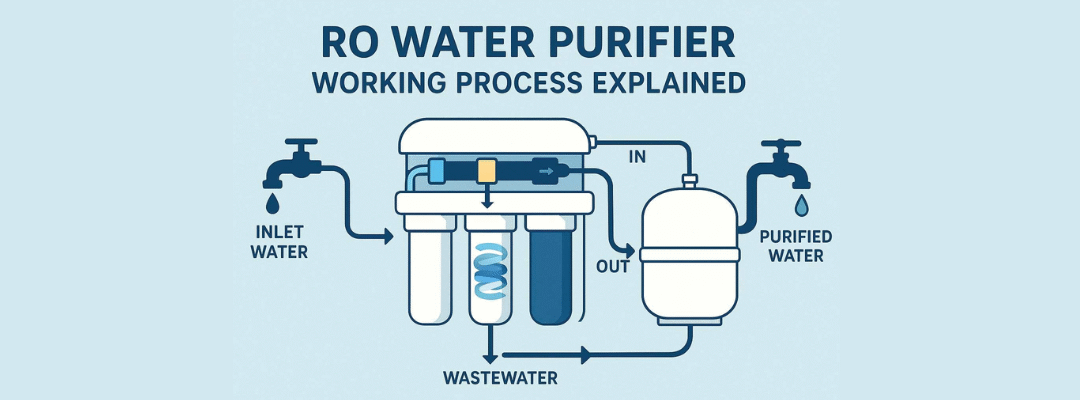Clean and safe drinking water is essential for every home, office, school, and industrial facility. However, with increasing contamination, dissolved salts, and chemical impurities, basic filtration methods no longer suffice.
This is where a Reverse Osmosis (RO) Water Plant becomes crucial.
In this guide, we’ll explain:
- What an RO water plant is
- How it works step-by-step
- Differences between RO, UV, and UF purifiers
- Signs you need one
- Tips to help you choose the right RO system
1. What Is an RO Water Plant?
An RO (Reverse Osmosis) Water Plant is a sophisticated water purification system that uses a semipermeable membrane to eliminate impurities like:
- Dissolved salts (TDS)
- Heavy metals (lead, fluoride, arsenic)
- Microorganisms (bacteria, viruses)
- Chemical pollutants
These systems are ideal for:
- Apartments
- Schools & hospitals
- Offices
- Industries
Key Functions of an RO Plant:
- Significantly reduces Total Dissolved Solids (TDS)
- Removes hazardous metals and chemicals
- Destroys harmful microbes
- Improves water taste and smell
- Protects long-term health
2. How Does an RO Water Purifier Work? (Step-by-Step Process)
RO systems typically involve several filtration stages:
Step 1: Pre-Filtration
Eliminates large particles (sand, rust, dust) to protect the membrane.
Step 2: Activated Carbon Filter
Removes chlorine and organic compounds that can damage the RO membrane.
Step 3: RO Membrane Filtration
Forces water through a membrane with pores as small as 0.0001 microns to remove dissolved salts and heavy metals.
Step 4: Post Carbon Filter
Polishes the water by enhancing taste and eliminating odors.
Step 5: UV or UF Disinfection (Optional)
- UV: Neutralizes bacteria and viruses using ultraviolet light.
- UF: Removes microbes and particles without electricity.
Step 6: Mineral Balancing
Adds essential minerals like calcium and magnesium for taste and health.
3. RO vs UV vs UF: What’s the Difference?
| Technology | Removes TDS | Kills Bacteria/Viruses | Best For |
|---|---|---|---|
| RO | Yes | Yes (with UV) | Hard/High-TDS Water |
| UV | No | Yes | Municipal Supply |
| UF | No | Yes | Low Chemical Areas |
Takeaway: Choose RO if your water has high TDS or visible scaling on taps and utensils.
4. Signs You Need an RO Water Plant
If you’re unsure whether to install an RO system, watch out for these signs:
- Salty or metallic taste in drinking water
- White scaling on faucets and utensils
- Cloudy or smelly water, often indicating microbial growth
- Health concerns like stomach troubles or skin issues
- Discoloration of stored water, which could point to rust or sediment
- Dependence on borewell or untreated groundwater
5. How to Choose the Right RO Water Plant for Your Needs
a) Test Your Water Quality
Use a TDS meter or get a water report from a certified lab to assess:
- TDS level
- Iron and fluoride content
- Bacterial presence
This will help you decide whether you need an RO-only or RO+UV+UF system.
b) Estimate Your Capacity Needs
| Usage Area | Recommended RO Capacity |
|---|---|
| Homes / Small Offices | 50–100 LPH |
| Schools / Institutions | 250–1000 LPH |
| Factories / Industries | 2000–10,000+ LPH |
c) Look for Automation Features
Advanced RO plants now offer:
- Auto membrane flushing to extend membrane life
- TDS monitoring sensors
- Smart shut-off during low or high pressure
d) Maintenance Support
Choose a system backed by:
- Good customer support
- Easy spare parts availability
- AMC options (Annual Maintenance Contracts)
e) Think Long-Term
Don’t decide based only on the upfront cost. Consider:
- Water recovery rate (how much water is wasted)
- Power consumption
- Spare part costs and service frequency
6. Benefits of Using an RO Water Plant
- Eliminates up to 99% of harmful impurities
- Ensures consistent, safe water supply for families and businesses
- Reduces appliance wear caused by hard water
- Saves cost and plastic waste by cutting bottled water use
- Helps meet BIS water quality standards for both homes and industries
Frequently Asked Questions (FAQs)
Q1: What does an RO Water Plant remove?
It removes TDS, metals, bacteria, and harmful chemicals, making water safe for consumption.
Q2: How often should I service my RO system?
Change filters every 6–12 months. Replace RO membranes every 2–3 years, depending on usage.
Q3: Can I use RO for borewell water?
Absolutely. RO systems are ideal for hard and high-TDS water like borewell sources.
Q4: Does RO remove good minerals too?
Yes, but advanced systems restore essential minerals using mineral cartridges.
Q5: What’s better — RO or UV?
Use RO for high TDS or chemical water. UV is suitable for low-TDS municipal supply with biological contamination.


Recent Comments